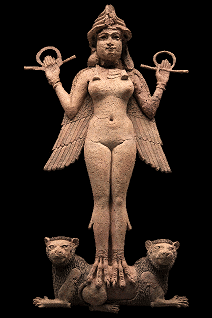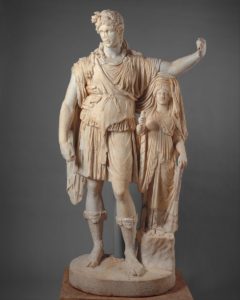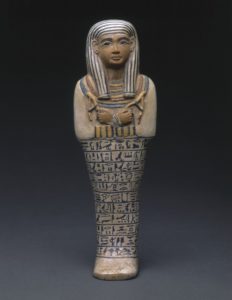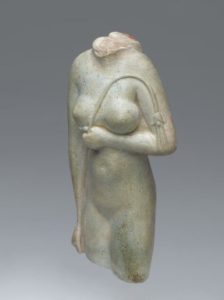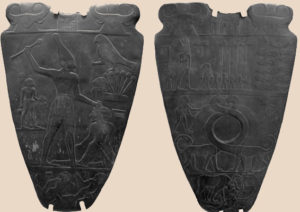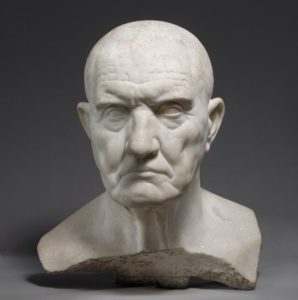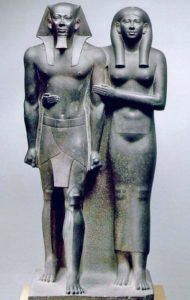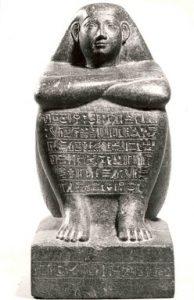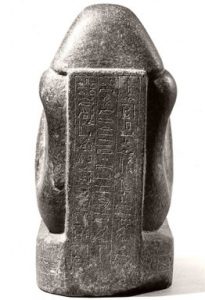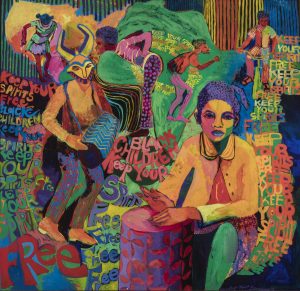Sadika Chowdhury
Art 1010 Final Paper
Prof. Shaw
12/10/18
The Role of Women in the Ancient World
Art is a huge part of ancient history. Ancient art provides insight from the past about many different civilizations. Ancient art displays the scenarios of society, cultures, and traditions of the ancient world. It reflects the life of people during that period as well as the role each plays, including, man, women, children, and God. In artworks from early civilizations such as Ancient Egyptian, Ancient Roman and Ancient Greek women were represented differently in each civilization. The way women were portrayed in art tells much about the status and roles of women in society and the place where men wanted them. Since prehistoric times women have been portrayed in art, giving an impression of the perception the artist and the culture they lived in, had of women. In ancient Greece, the main role of women in Greek society was as a wife bearing and raising children. The wives also performed women’s work which included spinning, weaving, baking bread, cooking, serving, cleaning, and fetching water. Women were not inferior to men in many ways. Men and women had different roles in ancient Greek society. Their role did not encourage women to excel in the areas that men took on. The men felt the women should be subservient to the men and men were head of the family. Similarly, in ancient Roman, women also seemed like someone in charged of taking care of family, children, and husband, they were in charge of taking care household, but the men were the head of the household. Women’s role can be seen in art as lower than man; women were not allowed to vote or rule. Since women did not usually have a public role, it emphasizes not actions she took in life but rather the characteristics which the Romans considered to be those of an ideal wife. For this reason in women in ancient Roman artworks seemed inferior socially. In ancient Egypt, although men and women had different roles in society. However, unlike in many ancient civilizations, women were much more free, although they were not equal with men, both men and women in ancient Egypt accepted that everyone had their roles in the natural order of the universe and that the roles of men and women were different. In the art, from the formal paintings on tombs, the Egyptian stereotype of a woman was that of wife and mother, the husband being the head of the household. She worked indoors (mostly), out of the Egyptian sun, so her skin was lighter than that of her male counterparts. When she died, she was painted red, as were the men, as this was the color of rebirth.
Shabty of Lady Sati

Artist: Unknown
Credit Line: Charles Edwin Wilbour Fund
Date: ca. 1390-1352 B.C.E.
Museum: Brooklyn Museum
Civilization: Ancient Egypt
This is the tomb of a woman, who is in the process of gender transformation. The ancient Egyptians believed that for a deceased woman to rebirth, she had to turn into a man. The woman transforms into a man to conceive herself so she can be reborn into the afterlife and live out eternity as a woman. Then, they were believed to come to life in the afterlife and help the deceased, especially with agriculture and manual labor. In the eyes of ancient Egyptians, the woman in this tomb has become a man, since she has a male face and hands since they are colored red, the “male” color. This use of color magically transformed her into a male being. In ancient Egyptian art, the color separate the gender, women were usually shown with whitish-yellow skin and men were shown with reddish-orange skin. A red face and hands also identified the deceased with the sun-god, Re, who traveled in a boat across the sky by day and into the land of the dead at night. This woman’s “male” red skin gave her access to transportation to the next life in the god’s boat. According to the Brooklyn Museum’s exhibition some background information from “A Woman’s Afterlife: Gender Transformation in Ancient Egypt” states that “the ancient Egyptians believed that in human reproduction it was the man who created the fetus, transferring it to the woman during intercourse, rebirth was impossible for a woman alone.” This clearly demonstrates the role of women in ancient Egypt, they were viewed as weak, they have to be supported by the men, and the men get full credits for her rebirth and even for to reproduce and conceive a child.
Queen Nefertari being led by Isis
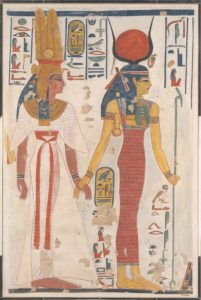
Artist: Charles K. Wilkinson
Date: ca.1279–1213 B.C.
Museum: The Metropolitan Museum of Art
Civilization: Ancient Egypt
This artwork displays queens Nefertari, who was the main wife of Pharaoh Ramses II. This watercolor depicts the queen being led by the goddess Isis. Note that it shows Nefertari without her husband, Ramses II, this indicating the queen’s high status that allowed her to interact with the deities without him directly. In the article “Women in Ancient Times” reveals a different aspect of women role in ancient Egypt, it talks about Cleopatra and Nefertiti. It states “she single-handedly controlled the most powerful throne at that time for 21 years (51– 12 August 30 BCE). She was the last active pharaoh of Egypt…Even during her exile and the Roman Civil War, she remained true to her title and held her own until her death at age 39.” this article also mentions that “Nefertiti reined Egypt with her husband Akhenaten until 1330 BCE, sometime before Cleopatra. She ruled briefly alone after her husband’s death. She changed the way women were viewed from a political and leadership standpoint.” Example of these two great women of ancient Egypt demonstrates that ancient Egypt was not entirely man-dominated, women role was also important, it did provide women with some rights, freedom, and control, unlike other civilizations.
Statue of Dionysos leaning on a female figure (“Hope Dionysos”)
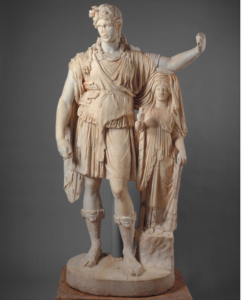
Artist: Pacetti, Vincenzo
Date: 27 B.C.–A.D. 68
Museum: The Metropolitan Museum of Art
Civilization: Ancient Roman
This is a figure of Dionysos, god of wine and divine intoxication. He is wearing a panther skin over his short chiton and his high sandals with animal heads on the overhanging skin flaps. He is also standing beside and leaning on a female figure. The size of the man and the woman figure in this artwork tells a lot of the role each play in the ancient Roman Society. The man figure is tall, the woman in short even though she is standing on a high stone, this is portraying the fact that no matter how hard the woman try she will still be below the man, and never will be able to reach the same height as the man. Also, it illustrates that woman and man are not equal; man is more superior. The male figure is leaning on the female figure’s head as if he is resting his arm which indicates that in Roman society a woman’s role is to take care of the family, children, husband, and to make sure the man is satisfied. In the article “The Role of Women in the Roman World” states “Roman women had a very limited role in public life. They could not attend, speak in, or vote at political assemblies and they could not hold any position of political responsibility…women were closely identified with their perceived role in society the duty of looking after the home and nurture a family.” This explains the artwork “Statue of Dionysos leaning on a female figure,” which reflects the role of women in ancient Roman society as inferior to men. Women and man had very different levels of status, and women were under incharge of man, there in the statue, the man put his arm on the woman’s head as displaying that she is his property and under his control.
Terracotta lekythos (oil flask)
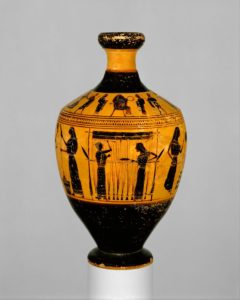
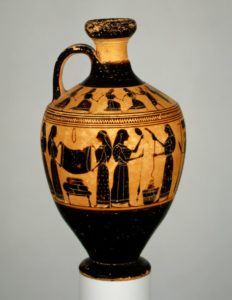
Artist: Unknown
Credit Line: Fletcher Fund, 1931
Date: ca. 550–530 B.C.
Museum: The Metropolitan Museum of Art
Civilization: Ancient Greece
The art in this vase represents the women’s role in ancient Greece society. It displays women are making woolen clothes. One of the most important responsibilities of women in Ancient Greek society was the preparation of wool and the weaving of cloth. In the center of the vase, two women work at an upright loom. To the right, three women weigh wool. Farther to the right, four women spin wool into yarn, while between them finished cloth is being folded. Similar to Roman society, Women in the ancient Greek world had few rights in comparison to male citizens. Unable to vote, own land, or inherit, a woman’s place was in the home, taking care of the home, raising children, preparing food and cook, and weave cloth. They journeyed outside of the home to fetch water and to attend festivals. In the article “Women in Classical Greece” Hemingway states that “young girls between the ages of five and puberty were selected to serve the goddess Artemis in her sanctuary at Brauron. As “little bears,” they acted out the role of untamed animals that eventually would be domesticated through marriage.” This indicates that there were many rules, rituals, regulations, restrictions, and societal norms associated with women, and these apply from birth and late as the age of five. In ancient Greek culture, Women didn’t have any rights. The men had all the power over them. In fact, this system is called patriarchy, when the father of the oldest male figure is the head of the household. Women were not even allowed to eat and sleep in the same room with men. Therefore, many of the Greek artworks portraits women doing activities inside the house, and surrounded by women, just as displayed in the vase artwork.
Hence, art tells stories, and if we look deeper into ancient history, we can see that the depiction of women in art, which tells the story of women during that period. Throughout the ancient world, women were portrayed and treated differently in their society. They were bounded by the rules, regulations, norms, rituals, and expectations. Different civilizations have displayed the role of women differently. Although in ancient Egyptian culture, women were much freer compared to ancient Greece and ancient Rome, but not all the women in ancient Egypt had that same opportunity to live freely, only high-class women had that in favor. One societal perception which was common in all of these civilizations which is women’s role in the society was inferior, while men were the superior in all the cultures. And perhaps still today, we can often see around the world how people still fighting for gender equality, equal pay, and equal rights. It is important to acknowledge and visit the ancient history and compare the fact that it has been over centuries, but still today the role of women have remained the same in many countries in the world. Since in the world women are still fighting for their rights and seeking for their position in society, it indicates that the societal perception of men and women’s role have always remained the same as the ancient time; we have just moved on with the time, but our ancient attitude have stayed in our head.
Works Cited
Cartwright, Mark. “The Role of Women in the Roman World.” Ancient History Encyclopedia, Ancient History Encyclopedia, 22 Feb. 2014, www.ancient.eu/article/659/the-role-of-women-in-the-roman-world/.
Hemingway, Colette. “Women in Classical Greece.” In Heilbrunn Timeline of Art History. New York: The Metropolitan Museum of Art, 2000–. http://www.metmuseum.org/toah/hd/wmna/hd_wmna.htm (October 2004)
Livermore, Melina. “Women in Ancient Times.” Art News Portal, 26 Oct. 2016, www.artnewsportal.com/art-news/women-in-ancient-times
“A Woman’s Afterlife: Gender Transformation in Ancient Egypt.” Organized by Edward Bleiberg, Brooklyn Museum: The Dinner Party by Judy Chicago, 15 Dec. 2016, www.brooklynmuseum.org/exhibitions/womans_afterlife_ancient_egypt.
Artworks from The Metropolitan Museum of Art and The Brooklyn Museum
